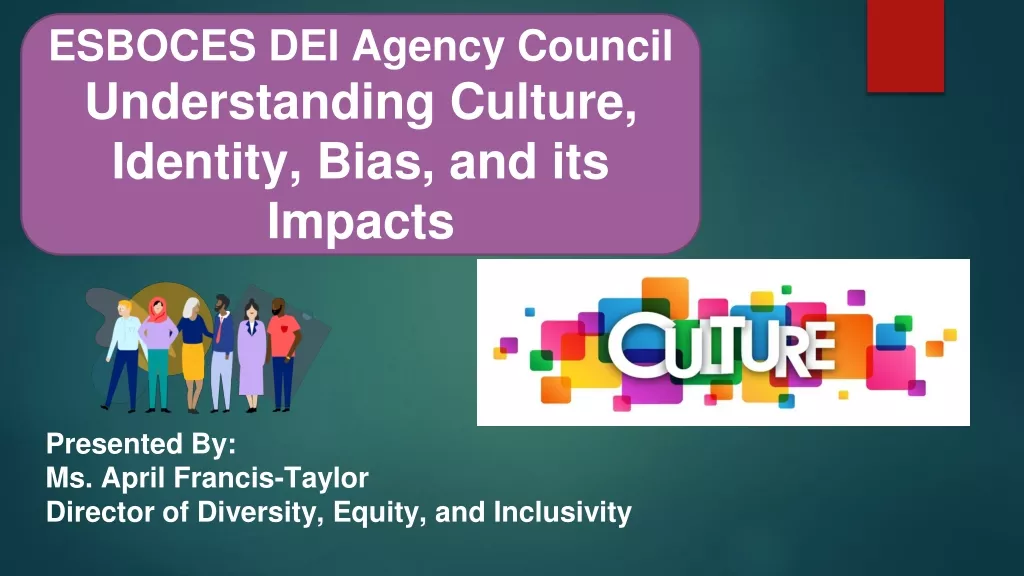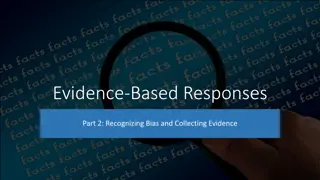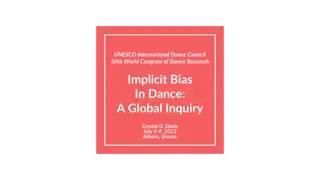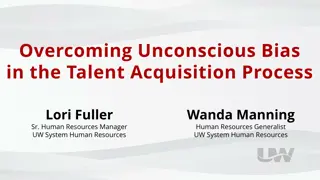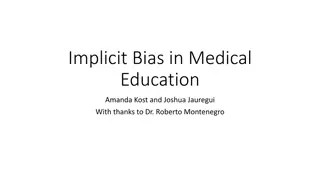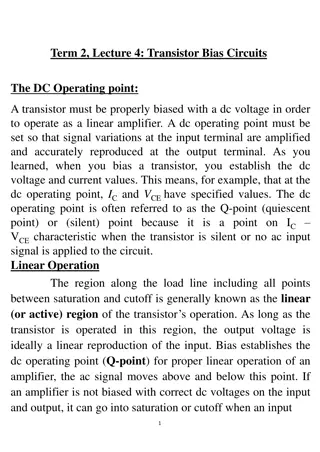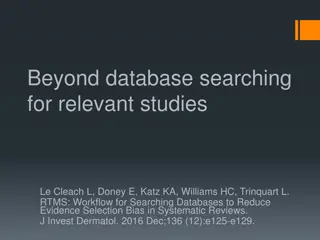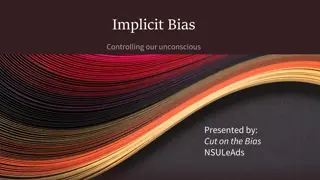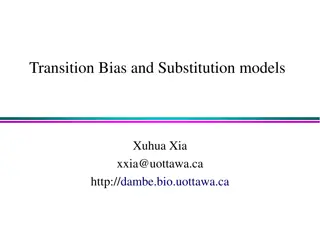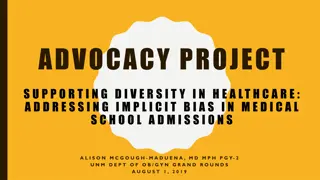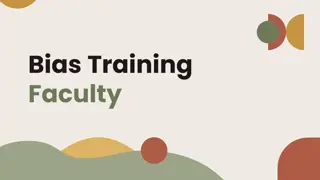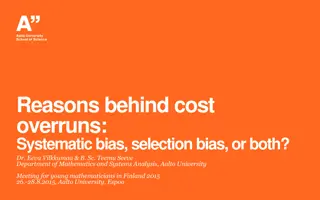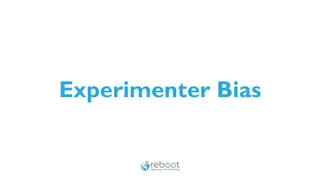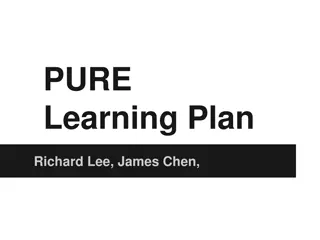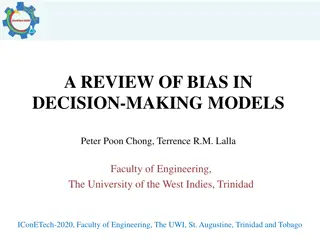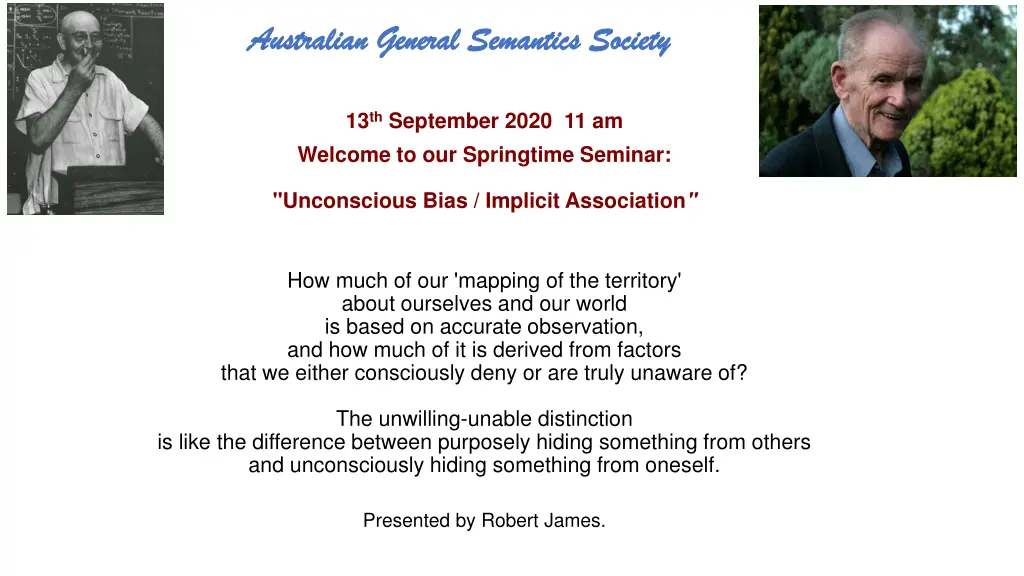
Understanding Implicit Bias: Unconscious Associations Revealed
Delve into the complexities of unconscious bias and implicit associations in this seminar by the Australian General Semantics Society. Explore how our perceptions are shaped by both conscious and unconscious factors, leading to biases that influence our view of the world. Examine the distinctions between willing and unwilling concealment of information and embark on a journey of self-discovery to unveil hidden biases within. Discover various types of biases and their effects on decision-making and perceptions.
Download Presentation

Please find below an Image/Link to download the presentation.
The content on the website is provided AS IS for your information and personal use only. It may not be sold, licensed, or shared on other websites without obtaining consent from the author. If you encounter any issues during the download, it is possible that the publisher has removed the file from their server.
You are allowed to download the files provided on this website for personal or commercial use, subject to the condition that they are used lawfully. All files are the property of their respective owners.
The content on the website is provided AS IS for your information and personal use only. It may not be sold, licensed, or shared on other websites without obtaining consent from the author.
E N D
Presentation Transcript
Australian General Semantics Society Australian General Semantics Society 13thSeptember 2020 11 am Welcome to our Springtime Seminar: "Unconscious Bias / Implicit Association" How much of our 'mapping of the territory' about ourselves and our world is based on accurate observation, and how much of it is derived from factors that we either consciously deny or are truly unaware of? The unwilling-unable distinction is like the difference between purposely hiding something from others and unconsciously hiding something from oneself. Presented by Robert James.
Our two brains Our two brains Conscious and Unconscious Conscious and Unconscious
Weve worked on this theme before Fourteen years ago, in March 2006, David referred to this in working on some of the formulations: http://members.pcug.org.au/~ajames/agsEvents2006March.htm 1) Identification a) Vertical identification of different abstraction levels, eg: Reification (identifying abstract concepts/formulations with concrete objects that do not exist) and Fact-Inference confusion. b) Horizontal identification. Where one treats A1 as identical to A2 - racism, sexism, ageism, etc. 2) Projection (seeing properties as projected out there, that you have made up in your nervous system.) i.e. projection ignores the observer-observed process. Either/Or thinking. It is easier to think in black and white polarised terms than in shades of grey. And how the Availability Bias helps make this happen. 3) Eight years ago, in August 2012, we had our Professor Gabriel Donleavy s presentation: http://members.pcug.org.au/~ajames/agsEvents2012August.htm
Implicit Association (Unconscious Bias) How much of our 'mapping of the territory' about ourselves and our world is based on accurate observation, and how much of it is derived from factors that we either consciously deny or are truly unaware of? The unwilling-unable distinction is like the difference between purposely hiding something from others and unconsciously hiding something from oneself.
Types of Bias 1 Anchoring Bias (1st information disproportionately influence later judgements. Related to contrast effect) 2 Availability Bias (Focusing on what you know / what is shown. Lack of perspective) 3 Bandwagon Effect (Aka group thinking. Doing like the others, social pressure) 4 Choice Supportive Bias (A choice unknowingly becomes cue of superiority, eg religion, partisanism) 5 Confirmation Bias (Searching for proofs of current point of view. Misinterpret contradictory evidences. 6 Ostrich Bias (Ignore or rationalize negative information) 7 Outcome Bias (Base the effectiveness of a decision on its outcome, neglecting other factors. 8 Overconfidence (Stop making decision based on facts after a series of successes) 9 Placebo Effect (The belief of an outcome improves its likeness. I'm not sure why it's classified as a bias) 10 Survivorship Bias (Only taking into account the positive outcomes, which gives irrelevant correlations) 11 Selective Perception (Ostrich + Confirmation combined?) 12 Blindspot Bias (Thinking that we are less biased than the next folk).
The Implicit Association Test (IAT) A controversial assessment in the field of social psychology intended to detect the strength of subconscious association between mental representations memory. Commonly applied to assess implicit stereotypes, eg biases in racial groups, gender, sexuality, age, and religion, as well as assessing self-esteem. It is not designed to assess what we think about the associations, It does not ask what we like . >800,000 subjects.
The Implicit Association Test (IAT) Limitations / Controversary Assesses familiarity or cultural knowledge irrespective of personal endorsement of that knowledge. Lack of empirical research justifying the diagnostic statements that are given to the lay public. For instance, feedback may report that someone has a [slight/moderate/strong] automatic preference for [European Americans/African Americans]. Lack of consistency if someone does the same test a number of times. Proponents of the IAT have responded to these charges, but the debate continues, as with other psychological assessments, eg: For personality (eg Myers Briggs), or For intelligence , etc
The Implicit Association Test (IAT) The Implicit Association Test (IAT) makes it possible to penetrate both of these types of hiding. The IAT measures implicit attitudes and beliefs that we are either unwilling or unable to report. Are you willing to unlock this door to your unconscious and have a peep inside ... ? So How did we go with our homework
IAT Outcomes! From Person-1: I have done a few of the implicit implication tests and they are rather enlightening and fun to do !
IAT Outcomes! From Person-2: I couldn't do the homework. G.S. principles keep popping up. For instance: In the "fat-thin" exercise, I couldn't ignore the fact that (even in the context of a test) I don't relate to individuals in terms of fat-thin, black-white, and so on. Over the years, I have had friends on both sides. I remember a similar problem with answering some questions in the Myers Briggs and other tests.
IAT Outcomes! From Person-3: Your data suggest a moderate association of Male with Science and Female with Humanities.
IAT Outcomes! From Person-4: Your data suggest a moderate association of Male with Science and Female with Humanities.
IAT Outcomes! From Person-5: Your data suggest a strong preference for thin people compared to fat people, a slight preference for straight people compared to gay , a slight preference for white people compared to coloured .
Cognitive Bias https://www.verywellmind.com/what-is-a-cognitive-bias-2794963#causes If you had to think about every possible option when making a decision, it would take a lot of time to make even the simplest choice. Because of the complexity of the world and the amount of information in the environment, it is necessary sometimes to rely on some mental shortcuts that allow us to act quickly. Cognitive biases can be caused by a number of things, but it is these mental shortcuts, known as heuristics, that play a major contributing role. While they can often be surprisingly accurate, they can also lead to errors in thinking. Other factors that can also contribute to these biases: Emotions, Limits on our ability to process information Social pressures Ageing can cause decreased cognitive flexibility.
A Structural Differential view <= The reality
A Structural Differential view <= The reality <= Limits on our perception
A Structural Differential view <= The reality <= Limits on our perception <= Personality (Optimistic, careful etc)
A Structural Differential view <= The reality <= Limits on our perception <= Personality (Optimistic, careful etc) <= Emotions
A Structural Differential view <= The reality <= Limits on our perception <= Personality (Optimistic, careful etc) <= Emotions <= Experiences
A Structural Differential view <= The reality <= Limits on our perception <= Personality (Optimistic, careful etc) <= Emotions <= Experiences <= Social pressures
A Structural Differential view <= The reality <= Limits on our perception <= Personality (Optimistic, careful etc) <= Emotions <= Experiences <= Social pressures <= Ageing diminished cognitive flexibility
A Structural Differential view <= The reality <= Limits on our perception <= Personality (Optimistic, careful etc) <= Emotions <= Experiences <= Social pressures <= Ageing diminished cognitive flexibility History
A Structural Differential view <= The reality <= Limits on our perception <= Personality (Optimistic, careful etc) <= Emotions <= Experiences <= Social pressures <= Ageing diminished cognitive flexibility History Culture
A Structural Differential view <= The reality <= Limits on our perception <= Personality (Optimistic, careful etc) <= Emotions <= Experiences <= Social pressures <= Ageing diminished cognitive flexibility History Culture Expectations
A Structural Differential view <= The reality <= Limits on our perception <= Personality (Optimistic, careful etc) <= Emotions <= Experiences <= Social pressures <= Ageing diminished cognitive flexibility <= History <= Culture <= Expectations <= Assumptions
Our Computer Future As we general semanticists are surely aware, all symbol systems have biases! They involve abstractions which require making choices. Postman (1993) argues that the computer is biased toward seeing the world in terms of numbers, and this bias leads to the claim that all our problems can be solved by fast calculations. (Needless to say, he disagrees with this claim.) These days, we re often not thinking about a computer , but by complex systems involving many disbursed computers, multiple ever-changing data bases, and complex algorithms. So can computer systems make complex decisions, devoid of silly human biases ?
Nah Computer algorithms would never be biased! Computers do as programmed, but this is not necessarily simple, especially with AI, eg: Biometric recognition (facial, voice, iris, etc), Public administration (eg Robo debt ), Romantic match-making (like RSVP), Decisions like Should we go to war? Autonomous weapons systems, Natural speech recognition, Criminal case-vetting, Weather forecasting, Economic modelling, Pandemic modelling, Satellite navigation, Robotic surgery, Data mining, Etc etc.
Nah Computer algorithms would never be biased! Computers do as programmed, but this is not necessarily simple, especially with AI, eg: Biometric recognition (facial, voice, iris, etc), Public administration (eg Robo debt ), Romantic match-making (like RSVP), Decisions like Should we go to war? Autonomous weapons systems, Natural speech recognition, Criminal case-vetting, Weather forecasting, Economic modelling, Pandemic modelling, Satellite navigation, Robotic surgery, Data mining, Etc etc. GIGO - garbage in garbage out fundamental to data processing. Complex data models have bias built into them, by the analysts, designers, and programmers who create them, and by choice of the data they are given to process. Bias is introduced by such factors as * Inaccurate mapping of territory , * Incomplete or non-representative data, * Selective reporting. Bias exists in to the limitations of the human beings who create the programs, select the data and interpret the results. Algorithms may be biased in adversarial terms, because of "the logic of the excluded middle .
A Case study - Microaggressions Microaggressions can be subtle, well-intentioned, indirect, eg: Where are you from? , You don't look Jewish / gay / autistic , You're the smartest black girl in the class! Can we think of other examples ?
Australian General Semantics Society Australian General Semantics Society Thank you Go thy way, and rationalize-away those pesky biases
Australian General Semantics Society Inc Very Interesting Annual General Meeting! Agenda M meSecretary s Report (Minutes 2019) President s Report

